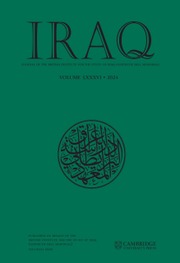No CrossRef data available.
Article contents
A SET OF SHARED PROVERBS FROM THE CEDAR FOREST TABLET OF THE STANDARD BABYLONIAN GILGAMESH AND THE BOOK OF QOHELET 4, 9-12
Published online by Cambridge University Press: 24 February 2025
Abstract
The article reconstructs lines 75–80 of Tablet V of the Standard Babylonian version of the Epic of Gilgameš. It offers a re-edition of all the extant sources and uses as a recourse verses 9–12 in Chapter 4 of the Book of Qohelet (Ecclesiastes). It then demonstrates how close the passage in the Epic of Gilgameš and the verses of the Book of Qohelet are. The article concludes with a brief discussion about the relationship between the Epic of Gilgameš and the Book of Qohelet.
مجموعة من الأمثال المشتركة من لوح غابة الأرز من ملحمة جلجامش البابلية القياسية وكتاب قوهليت Qohelet 4, 9-12
بقلم: يورام كوهين
تعيد المقالة بناء الأسطر 75-80 من اللوح الخامس من النسخة البابلية القياسية لملحمة جلجامش. وتقدم تصحيح جديد لجميع المصادر الموجودة وتستخدم أبيات شعرية 9-12 في الفصل الرابع من كتاب قوهليت كمرجع. ثم توضح مدى قرب المقطع الموجود في ملحمة جلجامش الى أبيات كتاب قوهليت. وتختتم المقالة بمناقشة موجزة حول العلاقة بين ملحمة جلجامش وكتاب قوهليت.
Information
- Type
- Research Article
- Information
- Copyright
- © The British Institute for the Study of Iraq 2025

